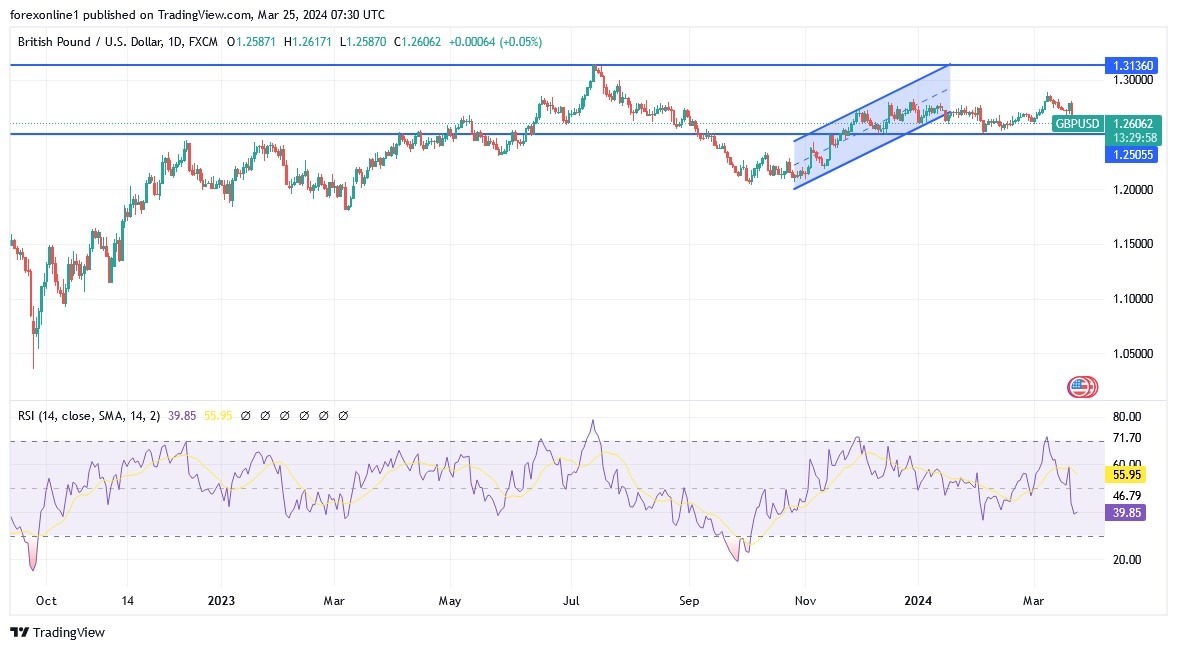- The downward pressure on the British pound increased after the Bank of England took a step closer to cutting interest rates.
- However, the weakness is expected to be limited as the bank continues to warn of inflation risks and the need for patience.
- According to forex market trading, the GBP/USD pair retreated to the support level of 1.2575, its lowest in over a month, and is hovering around 1.2600 at the time of writing.

Selling pressure on the GBP/USD increased after the Monetary Policy Committee voted by a majority of 8-1 to keep interest rates unchanged at 5.25%, with one member voting for a cut. Two members had voted for a rate hike in February, indicating a shift towards rate cuts in the coming months, explaining the pound's weakness. Kathleen Brooks, an analyst at XTB, commented, "This is the cautious pivot the market has been waiting for. No one voting for a rate hike opens the door to rate cuts in June."
The bank stated in its announcement that "monetary policy stance may remain constrained even if interest rates are lowered, as it began from an already constrained level." Moreover, this indicates that the bank believes it can lower interest rates without risking inflationary pressures. According to analysts, "this is a clear sign that the interest rate cut threshold is shifting somewhat lower."
The likelihood of an interest rate cut in June had risen to nearly 80% following recent developments. Commenting on this, Andrew Goodwin, chief UK economist at Oxford Economics, said, "We continue to call for the first rate cut to come in June, with two further cuts of 25 basis points each to bring the interest rate down to 4.5% by the end of this year." He added, "The inflation path now looks benign, and the need to maintain an extremely hawkish stance to protect against second-round effects appears less convincing."
However, the downward trend for the pound sterling will be limited due to ongoing warnings that the first interest rate cut will not occur until June or August. The bank stated, "Inflationary pressures have continued to ease, albeit slightly slower than expected and there are still material risks, particularly from developments in the Middle East, including disruptions to shipping through the Red Sea." This decision comes just hours after the release of the Purchasing Managers' Index (PMI) report for March, which showed increasing inflationary pressures on private sector firms in the UK, a factor the bank is keen not to exacerbate by cutting interest rates. Also, PMI surveys indicated an economic rebound extending into March, a view echoed by the bank, which noted that "business surveys continue to be consistent with expectations of activity improvement."
The accompanying statement to the decision has remained relatively unchanged, reaffirming the bank's commitment to ensuring no drastic market changes in expectations regarding the extent of future interest rate cuts. In particular, the report noted that "key indicators of ongoing inflation remain elevated. Monetary policy should remain constrained for a sufficient period to return inflation to the 2% target."
While sterling exchange rates initially fell in response to the bank's decision in March, any weakness is likely to be limited as the bank remains on course to cut interest rates alongside the European Central Bank and the Federal Reserve mid-year, meaning we expect recent ranges to remain intact. The bank's recent decision comes on the heels of midweek inflation data, which showed a faster-than-expected drop in the headline rate. However, inflation in key services reached 6.1%, an exceptionally high rate that does not satisfy the bank.
Meanwhile, the bank still has the option to lower interest rates after the Federal Reserve and the European Central Bank, according to some analysts.
Top Forex Brokers
GBPUSD Expectations and Analysis Today:
According to the performance on the daily chart, there is a noticeable downward shift in the performance of the price of the British pound against the US dollar GBP/USD. As we mentioned before, stability below the support 1.2600 will motivate the bears to take more control, and the next support levels for the performance may be 1.2550 and 1.2470, respectively, and from the last level. At a lower level, the indicators will begin to move towards oversold levels. On the other hand, resistance 1.2775 will remain the most important for bulls to control. Finally, trading is expected in narrow ranges until the Federal Reserve's preferred US inflation reading.
Ready to trade our daily Forex analysis? Check out the best forex trading company in UK worth using.
